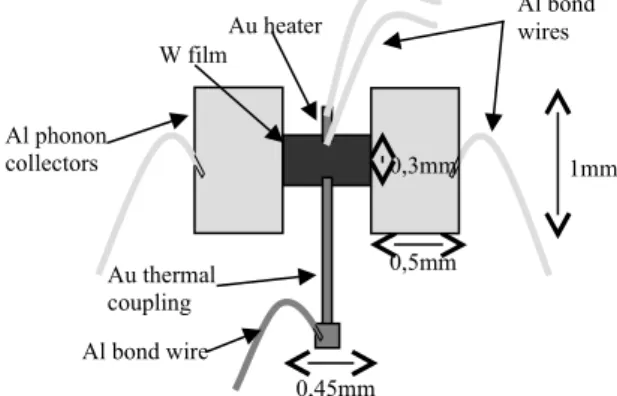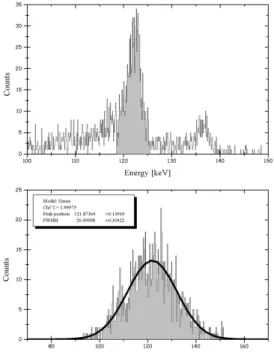Elsevier Science
Light detector development for CRESST II
F. Petricca,
*G. Angloher, C. Cozzini, T. Frank, D. Hauff, J. Ninković, F. Pröbst, W. Seidel and S. Uchaikin
Max-Planck-Institut für Physik, Föhringer Ring 6, D-80805 Munich, Germany Elsevier use only: Received date here; revised date here; accepted date here
Abstract
CRESST-II detector modules rely on the ability to actively discriminate electron recoils from nuclear recoils via simultaneous measurement of phonons and scintillation light. The scintillation light produced in each target crystal is detected via an associated calorimeter consisting of a thin silicon wafer read out by a tungsten phase transition thermometer deposited on its surface. About 1% of the energy deposited in CaWO
4is detected as scintillation light; therefore the sensitivity of the light detector is crucial for the discrimination of electron recoils from nuclear recoils at energies relevant for WIMP searches. We report the detector performance obtained using a thermometer geometry characterized by phonon collectors and a thin film thermal coupling to the heat sink. This concept allows a high sensitivity by decoupling the area required for the collection of non-thermal phonons and the heat capacity of the sensor. With a (30×30×0.45)mm
3light detector, energy thresholds below 5 keV referred to energy deposition in CaWO
4have been obtained. Results achieved will be presented and an overview on further possibilities of development will be given. © 2022 Elsevier Science. All rights reserved
Dark matter; CaWO4; scintillation light; light detector; phonon collectors
PACS: the PACS codes can be found at the home page of NIMA (left column, under Contents Services).
1. Introduction
CRESST-II is using scintillating crystals as absorbers for direct WIMP detection [1]. Since nuclear recoils release less light than electron recoils, the simultaneous measurement of phonons and scintillation light allows an active discrimination.
Typically about 1% of the energy of an electron recoil event in CaWO
4(the light yield depends critically on the crystal sample) is detected as scintillation light in a cryogenic light detector facing the crystal [2]. The sensitivity and the threshold of
light detectors are crucial for the discrimination in the relevant energy range (threshold to 40keV energy deposition in the CaWO
4crystal).
2. Light detectors
Light detector consist of an n-type (10km) silicon wafer (30×30×0.45)mm
3with 200Å SiO
2layer on both surfaces read out by a tungsten superconducting phase transition thermometer (SPT) deposited on one surface[3]. The silicon absorber is held on a copper holder by four thin Teflon tongues;
* Corresponding author. Tel.: +49-(0)89-32 354 316; fax: +49-(0)89-322 6704; e-mail: petricca@mppmu.mpg.de
1
Journal logo
Elsevier Science
each corner of the detector rests in a small hole in the Teflon.
The operating temperature of the W-SPT (typically about 10mK) is controlled by a heater coupled to the thermometer film. The same heater is used to inject heater pulses for monitoring the stability of the detector response and extrapolating the energy calibration from the 122 keV of the external calibration source into the region of interest (E<40 keV) [3].
2.1. Film geometry
An energy deposition in the silicon absorber creates high frequency phonons that spread ballistically over the crystal. The high frequency phonons which enter the thermometer deposit their energy into the electron system of the tungsten film
1rising its temperature. This absorption in the film competes with the thermalization of the high frequency phonons in the absorber. The temperature rise is governed by the heat capacity C of the thermometer film [4].
To increase the detector sensitivity the thermometer heat capacity can be reduced by decreasing its area
2. In a design where the thermometer alone provides the collecting area, the sensitivity gain is limited by the efficiency of the phonon collection process whose time constant is inversely proportional to the collecting area (for a 1mm
2W-film on a (30×30×0.45)mm
3Si wafer a typical time constant is of 2.5ms).
To overcome this limit a very small tungsten thermometer is combined with a phonon collector film of moderate size made of a superconductor with a much higher transition temperature.
2.1.1. Phonon collectors
The phonon collectors are aluminium films (10kÅ thickness) which form a proximity bilayer with the underlying tungsten film; the bilayer has a transition temperature close to the transition temperature of aluminium, therefore its heat capacity at the operating temperature of the detector is negligible.
1 At detector operating temperatures electrons and phonons are treated as thermally weakly coupled subsystems.
2 The W film thickness of CRESST W-SPTs is fixed at 2kÅ in order to efficiently absorb high frequency phonons.
The phonon collectors absorb the incoming flux of high frequency phonons and the excited quasi- particles transport the energy to the thermometer.
The size of phonon collectors is limited by the efficiency of this diffusive energy transport. In the present design the phonon collectors provide 1mm
2of collecting area; energy losses are expected to be negligible [5].
2.1.2. Heater and thermal link
The reduction of the heat capacity of the W-film is limited by the presence of additional structures needed for detector operation. In order to give a small contribution to the heat capacity of the system the heater is realized with a gold film structure of (0.1×0.25×0.0003)mm
3area.
The light emission of CaWO
4at low temperature occurs on a time scale of milliseconds. For optimal sensitivity the thermal relaxation time of the thermometer (=C/G) should be of the same order of magnitude to allow the integration of the incoming energy flux. A thin gold film structure ((1.5×0.1)mm
2, 500Å thickness) allows an adjustment of the thermal coupling G of the thermometer to the heat bath to obtain the desired
long integration time.
2
Fig. 1. Layout and connection scheme of the present light detector geometry. Al bond wires are used for electrical contacts, Au bond wire is used for the thermal link.
Al phonon collectors
Au thermal coupling
Au heater Al bond
wires
0,3mm 1mm
0,45mm 0,5mm W film
Al bond wire
Elsevier Science
3. Results
During the last months the light detectors described here have been used in the low background CRESST cryostat at LNGS [3].
3.1. Energy resolution
In a
57Co energy calibration the absorption of 122keV ’s in the scintillating crystal has been measured with 17% resolution in the light detector.
The result is comparable to values obtained at room temperature in a photomultiplier set up [1].Energy detection threshold
In a low background measurement at LNGS a long term base line noise of 1.4 keV FWHM referred to energy deposition in the CaWO
4has been measured.
This translates into a threshold of about 3 keV
referred to energy deposition in the CaWO
4. The signal quality can be inferred from (Fig. 3) which shows light and phonon signals of a 15 keV electron
recoil event. This energy corresponds to the
discrimination threshold proposed for CRESST II.
4. Next steps
To further improve the detector, next generation of light detectors will use a small portion of the thermal link as heater, electrically shorting the rest with a superconducting structure. This will allow to have a photolithography defined structure without an extra contribution to the heat capacity of the sensor.
Additional investigation on the possibility to increase the light absorption by coating or structural modification of the absorber surface is ongoing.
Acknowledgments
This work was supported by the DFG SFB 375
“Particle Astrophysics”, the EU Network HPRN-CT-2002-00322 on Applied Cryodetectors.
References
[1] G. Angloher, CRESST-II: dark matter search with scintillating absorbers, these proceedings.
[2] P. Di Stefano et al., submitted to J. of Appl. Phys.
[3] G. Angloher et al., Astropart. Phys. 18 (2002) 43-55.
[4] F. Pröbst et al., J. of Low Temp. Phys. 100 (1995) 695.
[5] M. Loidl et al., Nucl. Inst. and Meth. A 465 (2001) 440-446.
3
Fig. 2. 57Co calibration of a detector module. Top:
Spectrum measured by a 300g CaWO
4 phonon detector;
the shaded region indicates the 122keV peak. Bottom:
The same peak seen in the light detector.
Fig. 3. Simultaneous measurement of phonons and light in an underground run. The signal in the phonon channel (black) corresponds to 15 keV energy deposition.

